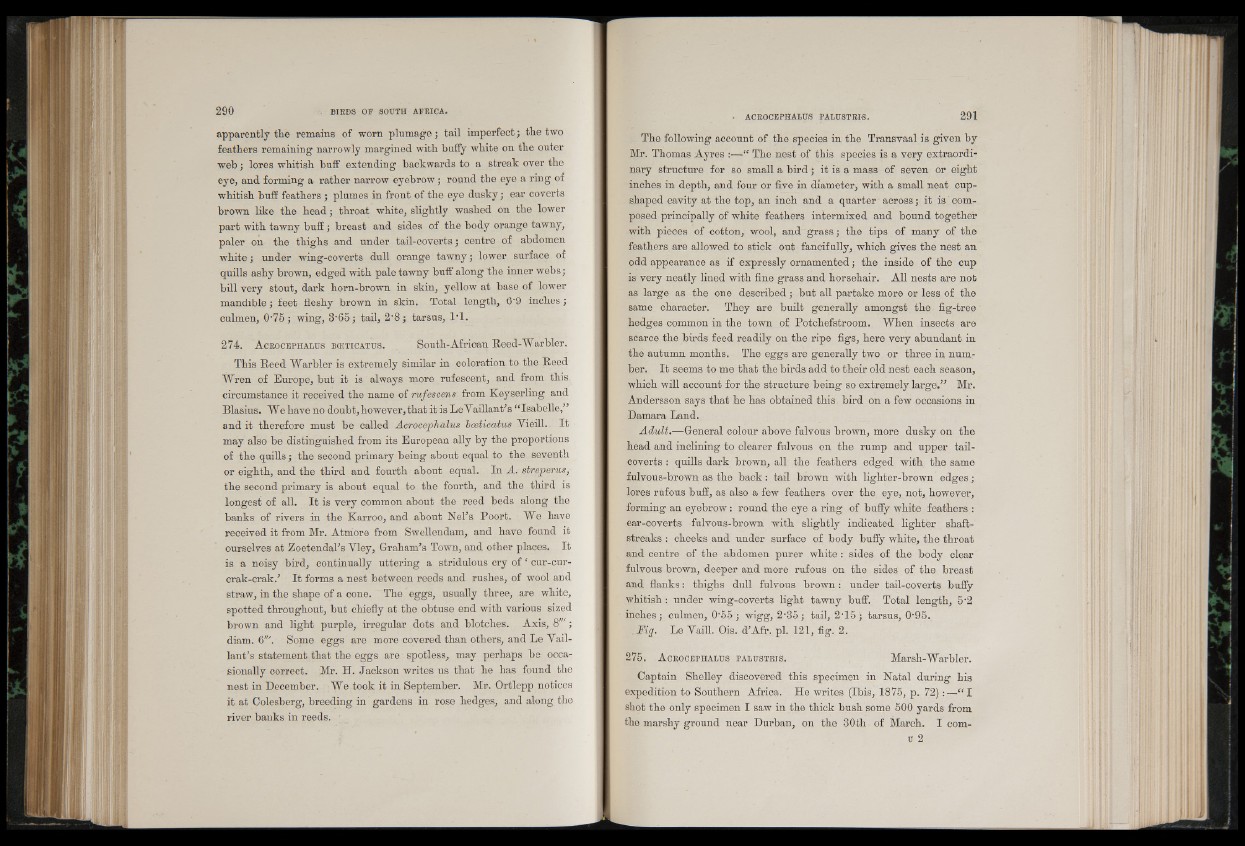
apparently the remains of worn plumage; tail imperfect; the two
feathers remaining narrowly margined with huffy white on the outer
web; lores whitish buff extending backwards to a streak over the
eye, and forming a rather narrow eyebrow; round the eye a ring of
whitish buff feathers ; plumes in front of the eye dusky; ear coverts
brown like the head; throat white, slightly washed on the lower
part with tawny buff; breast and sides of the body orange tawny,
paler on the thighs and under tail-coverts; centre of abdomen
white; under wing-coverts dull orange tawny; lower surface of
quills ashy brown, edged with pale tawny buff along the inner webs;
bill very stout, dark horn-brown in skin, yellow at base of lower
mandible; feet fleshy brown in skin. Total length, 6'9 inches;
culmen, 0-75; wing, 3‘65; tail, 2'8; tarsus, IT.
274. A crocephalus bceticatus. . S o u th -African Reed-Warbler.
This Reed Warbler is extremely similar in coloration to the Reed
Wren of Europe, but it is always more rufescent, and from this
circumstance it received the name of rufescens from Keyserling and
Blasius. We have no doubt, however, that it is LeVaffiant's “Isabelle,”
and it therefore must be called Acrocephalus bceticatus Viefll. It
may also be distinguished from its European ally by the proportions
of the quills; the second primary being about equal to the seventh
or eighth, and the third and fourth about equal. In A. streperus,
the second primary is about equal to the fourth, and the third is
longest of all. It is very common about the reed beds along the
banks of rivers in the Karroo, and about Neffs Poort. We have
received it from Mr. Atmore from Swellendam, and have found it
ourselves at Zoetendaffs VIey, Graham's Town, and other places. It
is a noisy bird, continually uttering a stridulous cry of ‘ cur-cur-
crak-crak.' It forms a nest between reeds and rushes, of wool and
straw, in the shape of a cone. The eggs, usually three, are white,
spotted throughout, but chiefly at the obtuse end with various sized
brown and light purple, irregular dots and blotches. Axis, 8"';
diam. Some eggs are more covered than others, and Le Vail-
lant’s statement-that the eggs are spotless, may perhaps be occasionally
correct. Mr. H. Jackson writes us that he has found the
nest in December. We took it in September. Mr. Ortlepp notices
it at Colesberg, breeding in gardens in rose hedges, and along the
river banks in reeds. ■
The following account of the species in the Transvaal is given by
Mr. Thomas Ayres :—“ The nest of this species is a very extraordinary
structure for so small a bird; it is a mass of seven or eight
inches in depth, and four or five in diameter, with a small neat cupshaped
cavity at the top, an inch and a quarter across; it is composed
principally of white feathers intermixed and bound together
with pieces of cotton, wool, and grass; the tips of many of the
feathers are allowed to stick out fancifully, which gives the nest an
odd appearance as if expressly ornamented; the inside of the cup
is very neatly lined with fine grass and horsehair. All nests are not
as large as the one described; but all partake more or less of the
same character. They are built generally amongst the fig-tree
hedges common in the town of Potchefstroom. When insects are
scarce the birds feed readily on the ripe figs, here very abundant in
the autumn months. The eggs are generally two or three in number.
It seems to me that the birds add to their old nest each season,
which will account for the structure being so extremely large.” Mr.
Andersson says that he has obtained this bird on a few occasions in
Damara Land.
Adult.—General colour above fulvous brown, more dusky on the
head and inclining to clearer fulvous on the rump and upper tail-
coverts : quills dark brown, all the feathers edged with the same
fulvous-brown as the back : tail brown with lighter-brown edges;
lores rufous buff, as also a few feathers over the eye, not, however,
forming an eyebrow : round the eye a ring of bufly white feathers :
ear-coverts fulvous-brown with slightly indicated lighter shaft-
streaks : cheeks and under surface of body bufly white, the throat
and centre of the abdomen purer white : sides of the body clear
fulvous brown, deeper and more rufous on the sides of the breast
and flanks: thighs dull fulvous brown: under tail-coverts bufly
whitish : under wing-coverts light tawny buff. Total length, 5'2
inches; culmen, 0‘55; wigg, 2-35; tail, 2T5; tarsus, 0-95.
Fiq. Le Vaill. Ois. d’Afr. pi. 121, fig. 2.
275. A crocephalus pa l u s t r is . Marsh-Warbler.
Captain Shelley discovered this specimen in Natal during his
expedition to Southern Africa. He writes (Ibis, 1875, p. 72):—“ I
shot the only specimen I saw in the thick bush some 500 yards from
the marshy ground near Durban, on the 30th of March. I comu
2